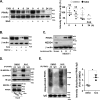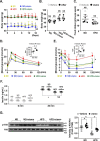Sonic hedgehog signaling instigates high-fat diet-induced insulin resistance by targeting PPARγ stability
- PMID: 30573683
- PMCID: PMC6398147
- DOI: 10.1074/jbc.RA118.004411
Sonic hedgehog signaling instigates high-fat diet-induced insulin resistance by targeting PPARγ stability
Abstract
Obesity is a major risk for patients with chronic metabolic disorders including type 2 diabetes. Sonic hedgehog (Shh) is a morphogen that regulates the pancreas and adipose tissue formation during embryonic development. Peroxisome proliferator-activated receptor γ (PPARγ) is a member of the nuclear receptor superfamily and one of the most important regulators of insulin action. Here, we evaluated the role and mechanism of Shh signaling in obesity-associated insulin resistance and characterized its effect on PPARγ. We showed that Shh expression was up-regulated in subcutaneous fat from obese mice. In differentiated 3T3-L1 and primary cultured adipocytes from rats, recombinant Shh protein and SAG (an agonist of Shh signaling) activated an extracellular signal-regulated kinase (ERK)-dependent noncanonical pathway and induced PPARγ phosphorylation at serine 112, which decreased PPARγ activity. Meanwhile, Shh signaling degraded PPARγ protein via binding of PPARγ to neural precursor cell-expressed developmentally down-regulated protein 4-1 (NEDD4-1). Furthermore, vismodegib, an inhibitor of Shh signaling, attenuated ERK phosphorylation induced by a high fat diet (HFD) and restored PPARγ protein level, thus ameliorating glucose intolerance and insulin resistance in obese mice. Our finding suggests that Shh in subcutaneous fat decreases PPARγ activity and stability via activation of an ERK-dependent noncanonical pathway, resulting in impaired insulin action. Inhibition of Shh may serve as a potential therapeutic approach to treat obesity-related diabetes.
Keywords: NEDD4-1; insulin resistance; obesity; peroxisome proliferator-activated receptor (PPAR); protein degradation; sonic hedgehog (SHH); type 2 diabetes; ubiquitylation (ubiquitination).
© 2019 Yao et al.
Conflict of interest statement
The authors declare that they have no conflicts of interest with the contents of this article
Figures







Similar articles
-
Dihydromyricetin enhances glucose uptake by inhibition of MEK/ERK pathway and consequent down-regulation of phosphorylation of PPARγ in 3T3-L1 cells.J Cell Mol Med. 2018 Feb;22(2):1247-1256. doi: 10.1111/jcmm.13403. Epub 2017 Nov 21. J Cell Mol Med. 2018. PMID: 29160030 Free PMC article.
-
A novel peroxisome proliferator-activated receptor gamma ligand improves insulin sensitivity and promotes browning of white adipose tissue in obese mice.Mol Metab. 2021 Dec;54:101363. doi: 10.1016/j.molmet.2021.101363. Epub 2021 Oct 25. Mol Metab. 2021. PMID: 34710641 Free PMC article.
-
An ERK/Cdk5 axis controls the diabetogenic actions of PPARγ.Nature. 2015 Jan 15;517(7534):391-5. doi: 10.1038/nature13887. Epub 2014 Nov 17. Nature. 2015. PMID: 25409143 Free PMC article.
-
Sonic Hedgehog Signaling and Hippocampal Neuroplasticity.Trends Neurosci. 2016 Dec;39(12):840-850. doi: 10.1016/j.tins.2016.10.001. Epub 2016 Nov 16. Trends Neurosci. 2016. PMID: 27865563 Free PMC article. Review.
-
Sonic hedgehog signalling pathway in CNS tumours: its role and therapeutic implications.Mol Brain. 2024 Nov 20;17(1):83. doi: 10.1186/s13041-024-01155-w. Mol Brain. 2024. PMID: 39568072 Free PMC article. Review.
Cited by
-
Research advances in intramuscular fat deposition and chicken meat quality: genetics and nutrition.J Anim Sci Biotechnol. 2025 Jul 16;16(1):100. doi: 10.1186/s40104-025-01234-5. J Anim Sci Biotechnol. 2025. PMID: 40665461 Free PMC article. Review.
-
Assessment of CircRNA Expression Profiles and Potential Functions in Brown Adipogenesis.Front Genet. 2021 Oct 22;12:769690. doi: 10.3389/fgene.2021.769690. eCollection 2021. Front Genet. 2021. PMID: 34745232 Free PMC article.
-
Lipid metabolism adaptations are reduced in human compared to murine Schwann cells following injury.Nat Commun. 2020 May 1;11(1):2123. doi: 10.1038/s41467-020-15915-4. Nat Commun. 2020. PMID: 32358558 Free PMC article.
-
Cell-Intrinsic Tumorigenic Functions of PPARγ in Bladder Urothelial Carcinoma.Mol Cancer Res. 2021 Apr;19(4):598-611. doi: 10.1158/1541-7786.MCR-20-0189. Epub 2021 Jan 11. Mol Cancer Res. 2021. PMID: 33431608 Free PMC article.
-
Whole transcriptome expression profiles in placenta samples from women with gestational diabetes mellitus.J Diabetes Investig. 2020 Sep;11(5):1307-1317. doi: 10.1111/jdi.13250. Epub 2020 May 13. J Diabetes Investig. 2020. PMID: 32174045 Free PMC article.
References
Publication types
MeSH terms
Substances
LinkOut - more resources
Full Text Sources
Miscellaneous

